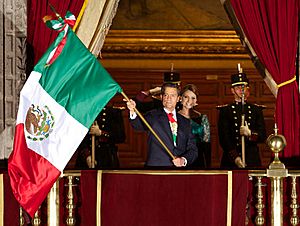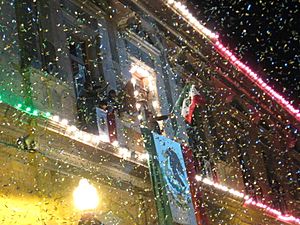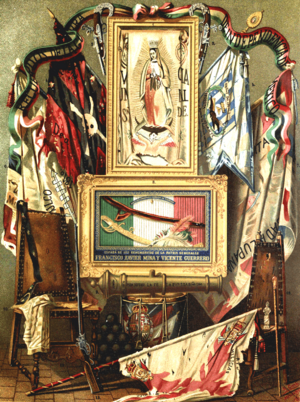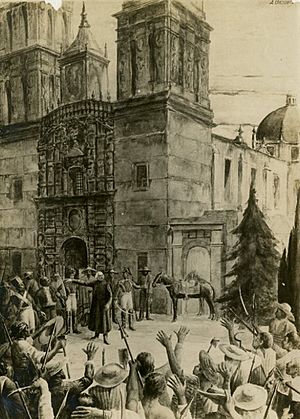Cry of Dolores facts for kids
Quick facts for kids El Grito de Dolores |
|
|---|---|

A statue of Miguel Hidalgo y Costilla in front of the church in Dolores Hidalgo, Guanajuato
|
|
| Observed by | Mexico |
| Significance | Commemorates the start of the Mexican War of Independence, by repeating the words of Miguel Hidalgo y Costilla in the early morning of 16 September 1810 |
| Date | 16 September |
| Next time | 16 September 2026 |
| Frequency | Annual |
The Cry of Dolores (Spanish: Grito de Dolores) is a famous event in Mexico. It happened in Dolores, Mexico, on September 16, 1810. A Catholic priest named Miguel Hidalgo y Costilla rang his church bell. He then gave a powerful speech, calling people to fight for freedom. This speech started the Mexican War of Independence. Locals often call it "El Grito de Independencia" (The Independence Cry).
Every year, on the night before Independence Day, the President of Mexico repeats this famous cry. He stands on the balcony of the National Palace in Mexico City. He rings the same bell that Hidalgo used in 1810. During his speech, the president honors the heroes who died fighting for independence. He ends by shouting "Viva Mexico!" three times. Then, the Mexican National Anthem plays.
Contents
How Mexico's Fight for Freedom Began
In the early 1800s, what we now call Mexico was known as New Spain. It was a part of the Spanish Empire. People started wanting to be free from Spanish rule. A man named José Bernardo Gutiérrez de Lara went to Dolores. He asked the local priest, Miguel Hidalgo, to help start a movement to free New Spain.
Gutiérrez de Lara traveled to Washington, D.C. to get military help. Meanwhile, Hidalgo stayed in Dolores. He was waiting for Gutiérrez de Lara to return. But Hidalgo feared he might be arrested. So, he told his brother Mauricio to free the prisoners who supported independence. Mauricio and armed men freed 80 prisoners early on September 16, 1810. Around 2:30 AM, Hidalgo ordered the church bells to ring. People gathered in front of his church. With Ignacio Allende and Juan Aldama by his side, Hidalgo spoke to the crowd. He urged them to revolt against Spain. This speech became known as the "Cry of Dolores."
The fight for independence lasted for ten years. The war finally ended on September 28, 1821. Mexico became a free country. Even though he didn't see the end of the war, Miguel Hidalgo is remembered as the "father of his country."
What Were Hidalgo's Exact Words?
Historians don't agree on the exact words Miguel Hidalgo said. Many different versions of his speech exist. One historian, Michael Meyer, said that the words are "reproduced in almost as many variations as there are historians."
However, the main idea of his message is clear. He wanted people to be free from Spanish rule. He asked them if they would fight for their freedom and their religion. He also spoke against the "bad government" of Spain. He shouted, "Long live Our Lady of Guadalupe! Death to bad government! Death to the Gachupines!" "Gachupines" was a negative word for people born in Spain. This strong anti-Spanish cry surprised many of Mexico's wealthy citizens.
How Mexico Celebrates This Important Day
The first celebration of September 16 happened in 1812 in Huichapan, Hidalgo. It became a national holiday in 1825.
The Cry of Dolores is now a very important symbol of Mexican independence. It marks the start of the Independence Day celebrations on September 16. Independence Day is a patriotic holiday in Mexico. People celebrate with parades, concerts, and special events. There are also drum and bugle competitions. National and local TV channels have special programs.
The President's Celebration in Mexico City

Every year on September 15, around 11 PM, the President of Mexico performs the Grito. He stands on the balcony of the National Palace in Mexico City. He rings the same bell that Hidalgo rang in 1810. This bell was moved to the National Palace. The President then recites a patriotic shout, based on Hidalgo's original "Grito de Dolores." He names important heroes of the Mexican War of Independence. The Grito always ends with three shouts of ¡Viva México!
The President's words can change a little each year. This might reflect current feelings or the President's personal style. Here is a common version of the Grito:
- Spanish
- ¡Mexicanos!
- ¡Vivan los héroes que nos dieron patria!
- ¡Viva Hidalgo!
- ¡Viva Morelos!
- ¡Viva Josefa Ortiz de Domínguez!
- ¡Viva Allende!
- ¡Vivan Aldama y Matamoros!
- ¡Viva la Independencia Nacional!
- ¡Viva México! ¡Viva México! ¡Viva México!
- English
- Mexicans!
- Long live the heroes who gave us our homeland!
- Long live Hidalgo!
- Long live Morelos!
- Long live Josefa Ortiz de Domínguez!
- Long live Allende!
- Long live Aldama and Matamoros!
- Long live the nation's independence!
- Long Live Mexico! Long Live Mexico! Long Live Mexico!
A huge crowd gathers below the balcony in the Plaza de la Constitución, also called the Zócalo. They come from all over Mexico and the world to hear the Grito. After the President says "¡Viva(n)!", the crowd shouts "¡Viva(n)!" back.
After the speech, the President rings the bell one last time. He then waves the Flag of Mexico to the cheers of the crowd. A military band plays the Mexican national anthem. Everyone sings along. The celebration ends with a spectacular fireworks show at the Zócalo.
On the morning of September 16, Independence Day, a national military parade takes place. It starts in the Zócalo and marches through Mexico City. It passes famous landmarks like the Hidalgo Memorial and "El Ángel de la Independencia" column.
Special Grito Celebrations
Sometimes, the Grito is performed in Dolores Hidalgo, Guanajuato. This is where the original event happened. This often happens in the President's last year in office. For example, President Felipe Calderón gave the Grito in Dolores Hidalgo in 2010. This was part of the bicentennial celebrations.
Presidents sometimes add their own personal touch to the Grito. This can sometimes cause discussion. President Vicente Fox often changed the words a bit. President Enrique Peña Nieto honored victims of earthquakes in his 2017 Grito.
In 2020, because of the COVID-19 pandemic, the Grito was done differently. It was performed remotely, without a large crowd.
Celebrations Across Mexico and Beyond

Similar celebrations happen in cities and towns all over Mexico. Mexican embassies and consulates around the world also hold events. The local leader, ambassador, or consul rings a bell. They recite the traditional words, including the names of local heroes. They end with the three shouts of Viva Mexico! The Mexican flag is waved, and everyone sings the National Anthem. Fireworks often follow. Schools in Mexico also have their own celebrations. Mexicans living in other countries, like the United States, also celebrate this important holiday.
See also
 In Spanish: Grito de Dolores para niños
In Spanish: Grito de Dolores para niños






